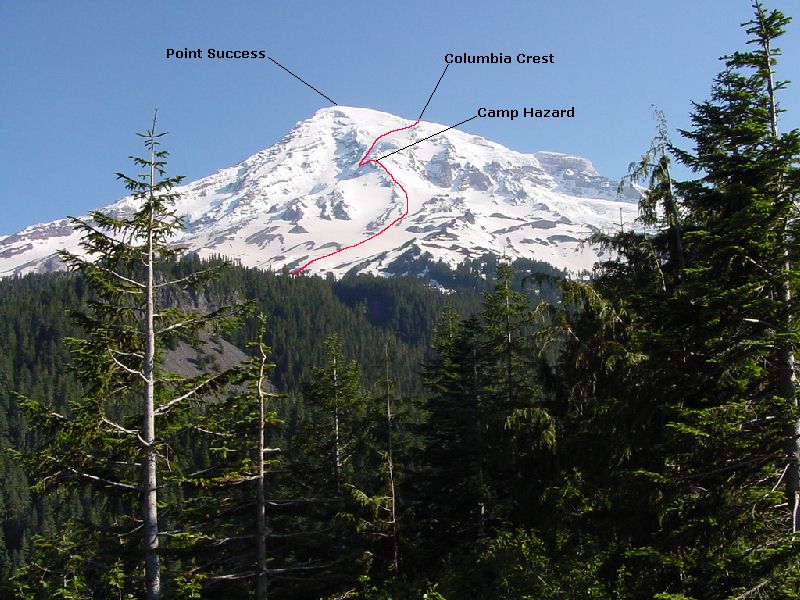The Kautz Glacier Route

This was my sixth ascent of Mt. Rainier and probably the most enjoyable to date. Good weather, snow conditions and company made this a great experience. There were seven people in our party, five leaving Paradise at 10:00 AM to take the normal route to the Camp Hazard area. This route goes from Paradise (5460') to glacier Vista (6,336') then descend 400' to the Nisqually Glacier. From here the glacier is crossed to the a gully known as the "Fan", then continues on to Wapowety Cleaver. Andy, arriving a bit later, met me at the Comet Falls Trailhead where we were starting up the route to Camp Hazard from Van Trump Park. We were hoping to make up for lost time by avoiding the glacier cross and taking advantage of trails to 7000' but it did mean starting a bit lower (c.3600'). See the previous report for Camp Hazard for more information on that approach.
|
The Kautz Glacier Route |
|
|
Andy and I met up with the group at about 9400' on Wapowety Cleaver. From here we continued up, some on the cleaver (tedious without snow) and some on the Turtle Snowfield. Our final resting place (for the night) was at about 10,900', far enough from the looming Kautz Ice Cliff but high enough for a short summit day.
|
Sunset from Camp at c.10,900 Feet |
|
|
In the morning Andy and I left camp just before 5:00 AM, the latest I had ever left a high camp on Rainier. We quickly climbed toward the ice cliff and the location of the gully leading to the Kautz Glacier.
|
Andy Johnson, roped and ready |
|
|
The gully is a bit scary, on a previous trip I watched blocks of ice fall off the ice cliff and down the gully. Needless to say we moved fast as we descended the 100' to 200' feet necessary to get around the ice cliff. Once around the ice cliff we began climbing up the Kautz Ice Chute (still moving fast). The chute has to steep sections to overcome, the first reaching 50 degrees for less than one full pitch and the second reaching 60 degrees for a little more than a pitch. Good snow conditions and a lack of ice allowed us to rapidly ascend the chute. This chute is generally considered to be the crux of the climb and is often ice rather than the snow we encountered. We had screws and second tools along...just in case.
|
The Kautz Ice Chute and Ice Cliff |
|
|
From the top of the chute the idea is to make something of a rising traverse across the Kautz Glacier to the top of the Wilson Glacier Headwall at c.13,300'. A few crevasses were encountered as we crossed the glacier, but these were easily negociated.
|
Checking out the view from c.13,300 feet |
|
|
At this point the route crosses onto the upper Nisqually Glacier and continues to the summit in a very direct fashion. The entire route is actually fairly direct, taking Andy and I about 3 hours and 45 minutes to climb from camp at c.10,900' to the crater rim at c.14,200'. The winds were not fierce by Rainier standards but were definitely present.
|
Andy finding no shelter from the wind at Register Rock |
|
|
After trudging across the crater to the summit area we signed the register, enjoyed some of the refreshments we had brought along and headed back down. The only difficulty on the descent was down climbing the upper section of the ice chute. We down climbed it facing in and using our second tools (we had to justify carrying them all the way from 3,600 feet to 14,411 feet somehow). The second tools were not necessary but undoubtedly speeded the descent of the 60 degree slope. The lower section of the chute was easily down climbed without a second tool or facing into the slope. Finally back to the gulley, we gave it everything we had to get up it quickly as a few small rocks and bits of ice whizzed by.
|
Descending past the ice cliff |
|
|
From camp we were able to take advantage of moderately steep snowfields and slippery pants to quickly glissade 3500' back to Van Trump Park and were back at the trailhead in under 2 hours.
References:
Selected Climbs in the Cascades Volume 2; Nelson, Potterfield; Pages 33-40
Cascade Alpine Guide, Volume 1, Second Edition; Fred Beckey; Pages 83-91, 96-98
Mount Rainier, A Climbing Guide; Mike Gauthier; Pages 93-96, 102-105